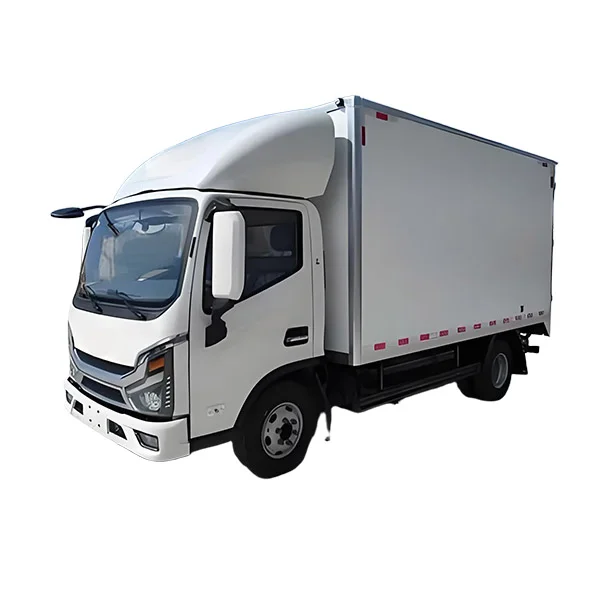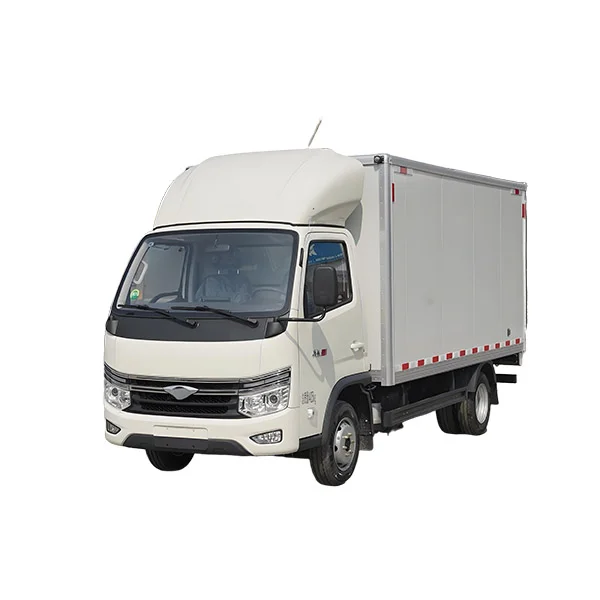
En el mundo de la protección de vehículos, pocos nombres llevan el peso de la experiencia como Shandong TaiRuiComo líder en soluciones compuestas avanzadas, fabrican carrocerías que se ríen frente a la corrosión: recintos termoplásticos sin costuras y paneles modulares para camiones diseñados para los trabajos más difíciles. Imagine esto: Usted’ Navegar por una flota a través de rutas costeras saladas o zonas industriales polvosas, y en lugar de preocuparse por la pintura escamosa, sus vehículos permanecen puros, ligeros y listos para la acción. Sus innovaciones provienen de años de I& D, centrándose en materiales que recortan el peso sin escatimarse en la resistencia, todo mientras esquiva las trampas de los metales tradicionales. Es’ no sólo sobre productos; es’ Se trata de asociarse con un equipo que consiga su perfección: la planificación nocturna de rutas, el presupuesto se apriete por soluciones inesperadas. ShanDong TaiRui convierte esos dolores de cabeza en triunfos, ofreciendo configuraciones que aumentan la eficiencia y la fiabilidad. Si la oxidación alguna vez ha marginado sus operaciones, sus enfoques a medida podrían ser el cambio de juego que necesita. Sumérgete más profundamente en su alineación, y ’ Veremos por qué los profesionales juran por estos guerreros a prueba de oxidación por vehículos especiales que exigen lo extraordinario.
Comprender la formación de oxidación y las vulnerabilidades
El oxido comienza sencillo: hierro en su vehículo’ El cuerpo metálico reacciona con oxígeno y agua, formando escamos de óxido de hierro que debilitan la estructura con el tiempo. Lo ves primero como manchas naranjas en el tren o los bordes, pero dejado sin marcar, se extiende como un incendio forestal, comprometiendo paneles y marcos. Los vehículos especiales amplifican estos riesgos. Piense en las bahías de carga irregulares que atrapan la humedad o las partes inferiores expuestas golpeadas por escombros. La sal de las carreteras de invierno o la humedad de los traslados marítimos aceleran el proceso, convirtiendo pequeños desgastes en revisiones importantes.
Puede detectar vulnerabilidades fácilmente: Compruebe las costuras donde se acumulan piscinas de agua, las soldaduras que se rompen bajo vibración y las superficies pintadas rayadas por ramas o herramientas. Las cargas pesadas agregan estrés, flexión del metal y grietas invitadoras. Abordar esto temprano, y usted recupera el control. Las medidas proactivas encajan perfectamente en su rutina, asegurando que su vehículo dure las estaciones sin el temor de averías.
Estrategias básicas de prevención
Construye una defensa fuerte con tácticas en capas que combaten la oxidación en sus raíces. Comience con hábitos que mantengan a raya los contaminantes, luego aplique ajustes ambientales y mejoras materiales. Estos pasos trabajan en tándem, creando una barrera que le permite enfocarse en el camino por delante en lugar del taller de reparación.
Prácticas de mantenimiento rutinario
Usted mantiene su vehículo’ Se puede lavar regularmente con un jabón suave y equilibrado en pH que levanta la suciedad sin quitar las capas protectoras. Enfoque en la parte inferior del cuerpo, donde la sal se esconde en grietas; una lavadora a presión lo quita, pero siga con una toalla de microfibra para secar cada pulgada. Salta esto, y la humedad permanece, alimentando la oxidación.
A continuación, aplique una cera o un sellante cerámico después de cada limpieza. Estos forman un escudo liso, repelente del agua como el aceite en una sartén caliente. Elija productos clasificados para uso automotriz: se unen a la superficie, llenando los micro arañazos que explota la oxidación. Se sella en la longevidad con este sencillo ritual.
Inspeccionar trimestralmente: Aparcar bajo luces brillantes y escanear burbujas en pintura o residuos en polvo. Costuras de sonda con una linterna; Las capturas tempranas significan tratamientos en el punto, no paneles completos. Herramientas como un borescopio revelan puntos ocultos sin desmontaje. Estas prácticas requieren poco tiempo, pero producen rendimientos masivos: su cuerpo se mantiene sólido, su billetera más llena.
Asocie esto a un cuidado más amplio: Registre cada sesión en un cuaderno o aplicación. Aparecen patrones: los controles posteriores a la lluvia aumentan después de los traslados húmedos, lo que lo guía para refinar su enfoque. El mantenimiento evoluciona con el uso, manteniendo la oxidación para siempre en la defensiva.
Controles Ambientales y Operacionales
Controle su entorno para eliminar la oxidación de su combustible. Garaje de su vehículo triunfa lotes abiertos; un simple carport bloquea la lluvia y los rayos UV que hornean sobre contaminantes. Si el espacio de almacenamiento es apretado, opte por cubiertas transpirables que eliminan la humedad.
Planifica las rutas con sabiduría: evita las carreteras saladas en invierno mapeando alternativas a través de aplicaciones como Waze. Para especiales fuera de carretera, ajuste las aletas de barro para desviar el spray. Estas opciones reducen la exposición a la mitad, aliviando la carga en su juego de mantenimiento.
Mejora el flujo de aire a continuación. Perforar agujeros de drenaje sutiles en puntos bajos o agregar aberturas de ventilación a las áreas de carga: el agua fluye fuera, no dentro. Transforma trampas potenciales en diseños inteligentes que respiren fácilmente.
Enlace de operaciones directamente aquí: Entrena a tu equipo en los enjuagues posteriores al viaje, especialmente después de carreras con salmuera pesada. Un descenso de la manguera de cinco minutos evita la acumulación durante la noche. Estos controles se combinan con su flujo diario, convirtiendo la prevención en una segunda naturaleza sin molestias adicionales.
Soluciones avanzadas de materiales y recubrimientos

Eleva tu estrategia con materiales que resisten la oxidación por diseño. El acero tradicional sucumbe eventualmente, pero los compuestos y los recubrimientos especializados ofrecen casi inmunidad. Cambias vulnerabilidad por resiliencia, especialmente en zonas de alta exposición como puertas y camas.
Considere las integraciones termoplásticas: se moldean en unidades de una sola pieza, borrando las juntas donde el agua se infiltra. Caja integrada termoplástica súper fuerte destaca aquí: su construcción no metálica evita la oxidación por completo, mientras que la resistencia al impacto de alta resistencia maneja las sacudidas de pozos o cargas. También gana un 40% de peso más ligero, aliviando los costos de combustible y aumentando la maniobrabilidad en sitios de trabajo apretados. Instalarlo en su camioneta de carga y ver como las estaciones pasan sin un solo pozo.
Los recubrimientos amplifican esto: los cebadores epoxi se unen profundamente en el metal, cubiertos por recubrimientos de poliuretano que se flexionan con el cuerpo. Aplicar en capas delgadas para una cobertura uniforme: los kits de bricolaje funcionan, pero los profesionales aseguran resultados perfectos. Estos soportan hasta 1.500 horas de pruebas de pulverización de sal, superando mucho a la pintura básica.
Para necesidades modulares, los cuerpos anti-expansión evitan huecos por calor o frío. El Cuerpo de camión de inserción (cuerpo de camión anti-expansión) sobresale: Los paneles se bloquean sin soldaduras, manteniendo sellos a través de oscilaciones de -40 ° C a 80 ° C. Se adapta fácilmente, reduciendo el tiempo de instalación y adaptándose a los cambios de flota. La fuerza se encuentra con la simplicidad, ideal para expandir su plataforma especial’ utilidad.
Mezcla estos con tus rutinas: recapa anualmente, inspecciona las integraciones estacionalmente. Opciones avanzadas don’ t reemplazar los elementos básicos; Los sobrecargan, entregando un cuerpo que prospera en el caos.
Integración de productos para una prevención óptima de la oxidación
Reúnelo todo tejiendo componentes especializados en su configuración. Seleccione en función de su vehículo’ Las demandas de la empresa (volumen de carga, terreno, clima) y las vulnerabilidades de observación desaparecen. Estas integraciones crean un escudo unificado, donde cada parte refuerza a la siguiente.
Comience con las cajas termoplásticas para los recintos de núcleo. Sustituyen las camas oxidadas directamente, ofreciendo paredes sin costuras que el agua puede’ t penetrar. La durabilidad brilla en los impactos: las pruebas de laboratorio muestran que absorben los golpes que muestren el acero y luego rebotan. Transporta más pesado sin preocupación, ya que el peso reducido libera carga útil para herramientas o mercancías.
Las inserciones modulares complementan esto, con ranuras en marcos para ajustes personalizados. La tecnología anti-expansión mantiene las alineaciones apretadas, bloqueando la humedad incluso cuando las temperaturas fluctúan. Los gerentes de flota adoran la escalabilidad: agregan secciones a mediados de temporada sin tiempo de inactividad. Combine ambos, y su cuerpo gana un 50% más de vida, según los parámetros de la industria.
La implementación fluye sin problemas: Mida su configuración actual, coincida con las especificaciones del producto y recluta a instaladores certificados para obtener precisión. Prueba post-ajuste con una manguera de agua: sin fugas significa éxito. Monitorear a través de escáneres anuales; Las aplicaciones rastrean patrones de desgaste, marcando ajustes tempranos.
Usted aborda las preocupaciones reales aquí: ¿Costo? Ahorro anticipado con menos correcciones. ¿Tiempo de inactividad? Los intercambios rápidos te mantienen en marcha. ¿Personalización? Dimensiones adaptadas a cualquier vehículo especial. Esta integración es’ t un perno; es’ es una reconstrucción que se alinea con tus objetivos, asegurando que la oxidación permanezca un recuerdo lejano.
Consejos de implementación y monitoreo
Implementa tu plan en fases para evitar abrumar. En primer lugar, audite su vehículo: Observe las áreas propensas a la oxidación y coincida con las estrategias. Priorice las reparaciones de alto impacto, como los intercambios termoplásticos, antes de los lavados de ajuste fino.
Presupuesto sabiamente: Factor de materiales a $500-$2,000 por sección, compensado por la mitad de las facturas de reparación durante cinco años. Fuente de proveedores fiables para las garantías que cubren los defectos.
Monitorear el progreso con los gadgets: medidores ultrasónicos miden el grosor del metal de manera no destructiva; pareja con cámaras térmicas para la humedad oculta. Establezca alertas de calendario para los controles: las inmersiones profundas posteriores al invierno detectan problemas rápidamente.
Refine a medida que avanza: Registre datos en una hoja de cálculo, detectando tendencias como el desgaste más rápido en los pozos de ruedas. Ajuste en consecuencia - sellante adicional allí, tal vez. Este bucle mantiene su sistema afilado, convirtiendo la prevención en una habilidad perfeccionada.
Conclusión y siguientes pasos
Usted’ Ya tienes el plan: Mantenimiento de capas, controles y materiales avanzados para fortalecer tu vehículo especial; cuerpo contra la oxidación’ agarre. Estas tácticas, arraigadas en la ciencia y probadas en el campo, le permiten conducir con confianza, milla tras milla. Su inversión se mantiene protegida, sus operaciones se simplifican.
¿Listo para actuar? Alcanzar para consultas sobre ajustes personalizados o instalaciones de servicio completo. Haga fila o visite el sitio para explorar opciones adaptadas a su flota. Vamos’ hacer de la oxidación una reliquia, juntos.
Preguntas frecuentes
P: ¿Con qué frecuencia debo inspeccionar mi vehículo’ s cuerpo para signos de oxidación?
R: Realice controles visuales cada tres meses, con sondas más profundas después de la exposición a condiciones climáticas duras. La detección temprana ahorra miles en reparaciones.
P: ¿Puedo aplicar estos métodos de prevención a un vehículo especial más antiguo?
R: Absolutamente, la adaptación de componentes termoplásticos o anti-expansión funciona en la mayoría de los marcos. Consulte a un especialista en compatibilidad para garantizar una actualización sin problemas.
P: Lo que hace que los materiales termoplásticos sean mejores que el acero tradicional para la oxidación ¿Prevención?
R: Los termoplásticos resisten la oxidación inherentemente, ya que carecen de metal’ propiedades reactivas. También alivian su carga hasta en un 40%, mejorando la eficiencia sin pérdida de fuerza.
